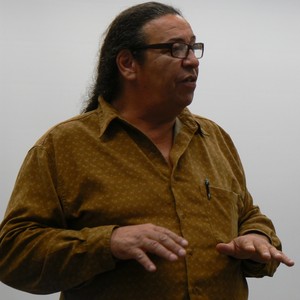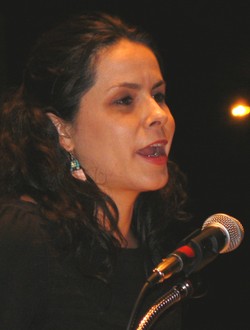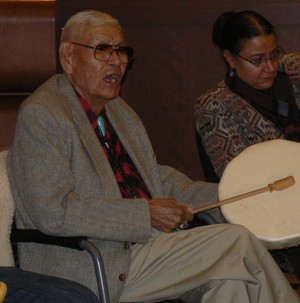When Kate Beane opens her classes on Dakota culture and history at Minneapolis Community and Technical College she asks students if they know the names of any American Indians.
Students often offer up Sitting Bull, Crazy Horse and other American Indian leaders of the 19th century.
She writes the names on the board and then she asks the students if they notice anything different about the list.
“Do you notice that nobody on this list is alive?” Beane asks.
“Do you know one living Indian ― one Dakota person?” she asks. And when she asks if the students know they are on Dakota land, the students look surprised.
Beane, a Dakota and a doctoral candidate at the University of Minnesota, is writing a dissertation that carries the working title, “Woyakapi Kin Akipi (Bringing the Story Home): The History of the Flandreau Santee Sioux Oyate.”
Beane spoke during the final session of “Unearthing the Truth: Rediscovering and Honoring our Dakota History,” an event Nov. 15 at Presbyterian Church (U.S.A.)-related Macalester College here, sponsored by the Synod of Lakes and Prairies and the college’s Center for Religious and Spiritual Life, Multifaith Council, Department of Multicultural Life, and Proud Indigenous People for Education (PIPE).
The event commemorated the 150th anniversary of the Dakota-U.S. war and the largest mass execution ever in the United States, when 38 Dakota men were hanged from a single scaffold on the day after Christmas at Mankato, Minn. in 1862
Earlier in the day, Bob Klanderud told event attendees that the war ultimately resulted from “Manifest Destiny,” a belief in 19th century America that the United States was destined to spread from the east to the west coast … no matter what.

Bob Klanderud —Duane Sweep
Klanderud, who works for the Division of Indian Work in partnership with the Minneapolis Council of Churches, a social-service organization for American Indians, spoke of broken treaties, a starving people who had lost their food sources and an eroding culture as the visible causes that resulted from “Manifest Destiny.”
Beginning in 1805, the Dakota and other American Indians who lived in what became Minnesota agreed to make concessions of land for specific uses by the U.S. government, according to an online resource published online by the Minnesota Historical Society. By 1858, when Minnesota became a state, the Dakota had been restricted to a ribbon of land along the Minnesota River.
“If you take a people away from their known land, their familiar surroundings and environment,” Klanderud said, and put them on a reservation, “they’re more submissive and easier to control. The method at the time was to beat the Indian out of the person.”
Klanderud, who carries a Norwegian surname, is more easily identified, he said, “with the half of me that is more obvious. I was never called Norwegian.”
“In 1862 the [Dakota] people were pushed to that place where at some point you have to take a stand for your very life and the lives of your wife, children and family,” he said.
Hunger was widespread throughout Dakota lands in Minnesota Territory. Because crops had been poor in 1861 and hunting space had been restricted, little food remained for the Dakota. In August 1862 government payments guaranteed in the treaties had not arrived.
The Mdewakanton leader Taoyateduta ― which translates as “His Scarlet Nation” though he is better known as Little Crow ― led the Dakota. Arguing for the release of food from the Lower Sioux Agency warehouse, Little Crow is quoted as having said, “We have waited a long time. The money is ours but we cannot get it. We have no food but here these stores are filled with food. … When men are hungry, they help themselves.”
It is widely accepted that the war began Aug. 17 when four Dakota hunters killed five white settlers. On Aug. 18 the Dakota declared war on the United States.
Little Crow is quoted as saying, “Taoyateduta is not a coward. He will die with you.”
Estimates put the August-September war’s death totals at more than 600 white people and between 75 and 100 Dakota warriors.
When the war ended, the Dakota were exiled from Minnesota, many dying as captives and many more dying during the forced relocation to Nebraska and South Dakota. Nearly 400 Dakota men went on trial, some trials lasting as little as five minutes, and 303 were sentenced to be hanged.
U.S. President Abraham Lincoln reduced the number to be hanged to 39 and in the end 38 went to the gallows at one time.
Little Crow and some of his followers left Minnesota when the Dakota had been defeated. When he returned to the state in 1863, Little Crow was shot and killed by a farmer, who collected a bounty for shooting the Dakota leader.
Little Crow was a “patriot, not a renegade,” according to the Rev. Sidney Byrd, a 93-year-old retired Presbyterian minister who is a member of the Santee Sioux Tribe.
Byrd said, “Little Crow died a hero.” The Dakota people had gone to war “to defend ourselves, our land and our way of life.”
Byrd, who sang twice in the Dakota language during his presentation, said, “It depends [on] who writes the history. We didn’t write the history.”
Describing himself as “Santee by birth and a Christian by choice,” Byrd used analogies with World War II and the American Revolution to describe the Dakota-U.S. War.
“When the Japanese warplanes attacked Pearl Harbor, it was the most successful sneak attack on an American military installation. … We couldn’t believe it ― shocked.” The United States responded, he said, with, “By golly, we’re going to defend ourselves and our way of life.” The war was called a just war.
“When we [the Dakota] did exactly the same thing ― to stand up to defend ourselves, our land and our way of life, it was called an insurrection, an uprising,” Byrd said.
Byrd quoted Patrick Henry’s familiar line: “Give me liberty or give me death,” and pointed out, “That’s what Little Crow did. He was ready to die for liberty.” Little Crow, Byrd said, “died a hero.”
The Dakota people still struggle with the aftermath of the war ― beyond the hangings and beyond the imposition of exile.
“We have a terrible time,” Byrd said, “taking our rightful place in this great nation with dignity, honor and respect.”
Sasha Brown knows that very well. Brown, who kicked off the event’s last session ― an attempt to describe the Dakota today ― is a sixth generation descendant of the Dakota removal from Minnesota. A member of the Santee Sioux Tribe in Nebraska, Brown is an academic adviser to American Indian students at Minneapolis Community and Technical College.
“The consequences continue to reverberate through our [Dakota] community,” Brown said.
“What happens to a tribe, a people, a community … when they are removed from their traditional homeland and removed to a completely different environment where they have no connection?” Brown asked.
The answers, Brown said, are found in a “multigenerational trauma” that can be found on the reservations of the Dakota ― struggles with alcoholism and addiction that extend from one generation to the next..
Using her father as an example, Brown said he “was never exposed to his language, his history, his culture. … He did not know that Minnesota was the birthplace of the Dakota people.”
The Dakota diaspora need rediscover what took years for her father to learn. The Dakota, she said, need to know “it’s okay to be Indian. It’s okay to be proud of who you are.”
As a people, Brown said, “Our history is not going to end after this 150th year’s commemoration of these events.”
That’s part of the challenge and a real challenge, too, for Beane, who helps students discover Dakota culture and history in a college classroom.
Beane, a Flandreau Santee Sioux, had been a high school dropout. “I didn’t see myself in the curriculum,” she said. “I didn’t see that it was important for me to be there because I wasn’t being told about myself. I didn’t see my people being represented.”

Kate Beane, a college lecturer on Dakota history —Duane Sweep
Beane said she’s been “very leery about” all the 150th year commemoration activities. She’s concerned, she said, the events will be soon forgotten when the anniversary year is past ― the Dakota will simply fade away into the background. “We can’t simply let others define us by land and by war,” Beane said.
And if the government apologizes to the Dakota for removing them from their homeland, for destroying their way of life and stripping away their culture, will that be enough?
Next steps will be difficult. When the U.S. government made a “settlement” with the Dakota late in the 20th century for the loss of land, it was “less than a nickel an acre,” said Dean Blue, a panel participant in the event’s last session.
Blue is a member of the Dakota tribe of the Upper Sioux Reservation and a longtime elder at Pejuhutazizi Presbyterian Church in Granite Falls, Minn., a church of non-geographic Dakota Presbytery. Blue said the Dakota were told to “get out of Minnesota or you’re dead.”
When the Dakota were gone, the U.S. government then ceased any payments under previous treaties. The rationale, Blue said, was that “there is no one there to pay this money to now so I guess we don’t have to pay for it.”
That makes for a tenuous relationship between the U.S. government and the Dakota. “So when we talk about today,” Blue said, “it’s very difficult for us to trust the government.”
From Beane’s perspective, apologies are “really important,” but she added, “At the same time, I wonder what important action is going to follow those apologies.”
Beane called for education reforms ― reforms that will recognize Dakota history in Minnesota classrooms and reforms that include tribal colleges and the teaching of the Dakota language. She also called for reform that will allow “Dakota to prosper, to take care of one another and take care of our land.”
Fern Cloud, pastor of Pejuhutazizi Presbyterian Church and also a panel participant, said the Dakota do not need to disappear from the landscape. “All we have to do is be in touch with who we are and have that passion to be visible and have that inner pride that this is our homeland,” she said.
Cloud, who is also a member of the Sisseton-Wahpeton Dakota, said the passion can bring about action. “We can make an impact in Minnesota.”
Any action and reform, according to Beane, needs to be more than one-way. Beane said she was “not talking about taking from one another, but talking about how best to cohabit this state that we all live in.”
Duane Sweep is associate for communications of the Synod of Lakes and Prairies. He is a frequent contributor to Presbyterian News Service.

